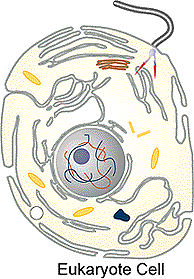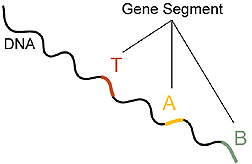
1. The answer is "a". If you missed this question you may want to go back and read in the text the pages indicated by G-1 concerning ribosomes and nucleoli. The nucleoli consists of RNA, DNA and protein. The nucleoli directs the synthesis of the cytoplasmic ribosomes. Identify the nucleoli and ribosomes in the figure below.

Press here to go back to the readings. press
2. The answer is "d". The chromatin is made up of uncondensed DNA and
protein.
Press here to go back to the readings. press
3. The answer is "d". Review the pages in the text indicated by G-1.
Press here to go back to the readings. press
4. The answer is "d". The centriole consists of protein microtubules,
not found in plant cells and acts an an organizing center for spindle fibers.
Locate the centrioles in the figure below.

Press here to go back to the readings. press
5. The answer is "f". The structure indicated by the arrow is endoplasmic
reticulum. All of the other answers match correctly.
Press here to go back to the readings. press
6a. The correct answer is "a". The DNA in a working cell is in the
form of chromatin.
Press here to go back to the readings.
Press
6. The answer is "d". You may want to go back and review the function
of the nucleus presented in miniunit Beta and write these in your notes.
Press here to go back to the readings. press
7. The answer is "d". There are many genes on one chromosomes. Each
chromosome consists of one DNA molecule. There are millions of genes
in the human genome, but only twenty three pair of chromosomes. This would
mean that there must be several genes on a single chromosome.
Press here to go back to the readings. press

8. The answer is "d". Genes are those traits which are passed from
one generation to another. However these traits may be altered by the environment.
Press here to go back to the readings. press
9. The answer is "b". Write a sentence in your notes contrasting between
diploid and haploid.
Press here to go back to the readings. press
10. The correct answer is "c". These are not homologous because one
chromosomes has a gene sequence of C,F and H and the other T,A and b. Draw
and identify the correct answers in your notes.
Press here to go back to the readings. press
11. The correct answer is "b". There are 6 chromosomes is the figure.
Each chromosome consists of two strands connected together.
Press here to go back to the readings. press
12. The correct answer is "a".
Press here to go back to the readings. press
13. The correct answer is "c". Draw this figure in you notes and label.
Press here to go back to the readings. press
14. The answer is "e". Forty-six chromosomes or 23 pair.
Press here to go back to the readings. press
15.
Press here to go back to the readings. press
16. The answer is "c". In group "C" there are 16 chromosomes and 8
pair. How many chromosomes and chromosomes pair are there in set "D"?
(6-3).
Press here to go back to the readings. press
17. The answer is "c". Each chromosome consists of a single DNA molecule.
Press here to go back to the readings. press
18. The answer is "b". You have 46 chromosomes and 23 pair. One
of the 23 pair determines your sex. These are called sex chromosomes and
indicated as XX or XY.
Press here to go back to the readings. press
19. The answer is "d". The total of all your genes is called
a human genome.
Press here to go back to the readings. press
20. The answer is "b". The daughter cells formed by mitosis always
contain the same chromosome compliment as the mother cell. Not only do
the daughter cells have the same number of chromosomes but they are genetically
alike.
Press here to go back to the readings. press

21. The answer is "d". The shaft (hair) produced by the follicle is
not cellular.
Press here to go back to the readings. press
22. The answer is "e". Meiosis in animals results in gametes
(sperm and egg).
Press here to go back to the readings. press
For information on how to use this page, go to How
to Use This Site.
Created by the Center for Learning Technologies, Academic Technology Services.
Last modified October 22, 1997.